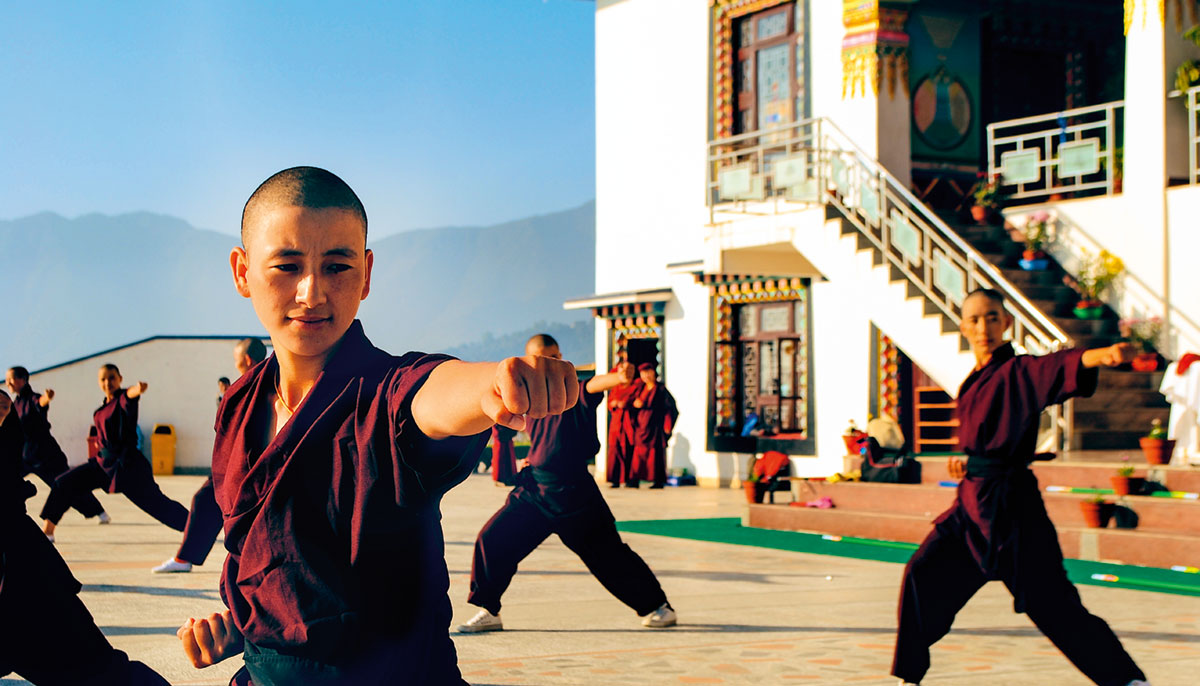“Which way to Seto Gumba?” my taxi driver calls out the window every few minutes. Amid the morning cacophony of honking horns, construction buzz, and the grating of metal shop gates being pushed open for business, we wind our way up the narrow, snaking streets of the outer ring of Kathmandu. Each shopkeeper, pedestrian, and driver questioned responds with the offhand wave of an arm indicating, “Up the road.” So, along with other sputtering, noisy vehicles, we continue up the steep incline.
Finally, we break free of the traffic to complete our ascent to Seto Gumba—the “White Monastery”—which is the locals’ name for the Druk Amitabha Mountain Monastery complex. It sits high above the dusty, congested hustle and bustle of Kathmandu and feels a world away.
The site was acquired in 1989 by His Holiness the Twelfth Gyalwang Drukpa, the dynamic spiritual leader of the Drukpa lineage of Himalayan Buddhism. It is now home to Druk Gawa Khilwa nunnery, a center for spiritual practice and humanitarian causes. Approaching the monastery, I have my first glimpse of the Drukpa nuns and their hands-on stewardship. They’re forming a roadside cleaning detail.
The Drukpa nuns are trailblazers, fearlessly addressing gender equality, the environment, and other issues demanding compassionate social action. In the popular press they’re known as the “Kung Fu Nuns” because of their rigorous daily practice of the martial art, which they use to spark discussion and raise awareness about the poor treatment of women and girls in Nepal and India. This past fall they made their first trip to the United States to receive the prestigious Game Changer Award from the Asia Society, in addition to attending discussions at the United Nations about human trafficking in post-earthquake Nepal, all the while rocking audiences with demonstrations of their martial arts skills.
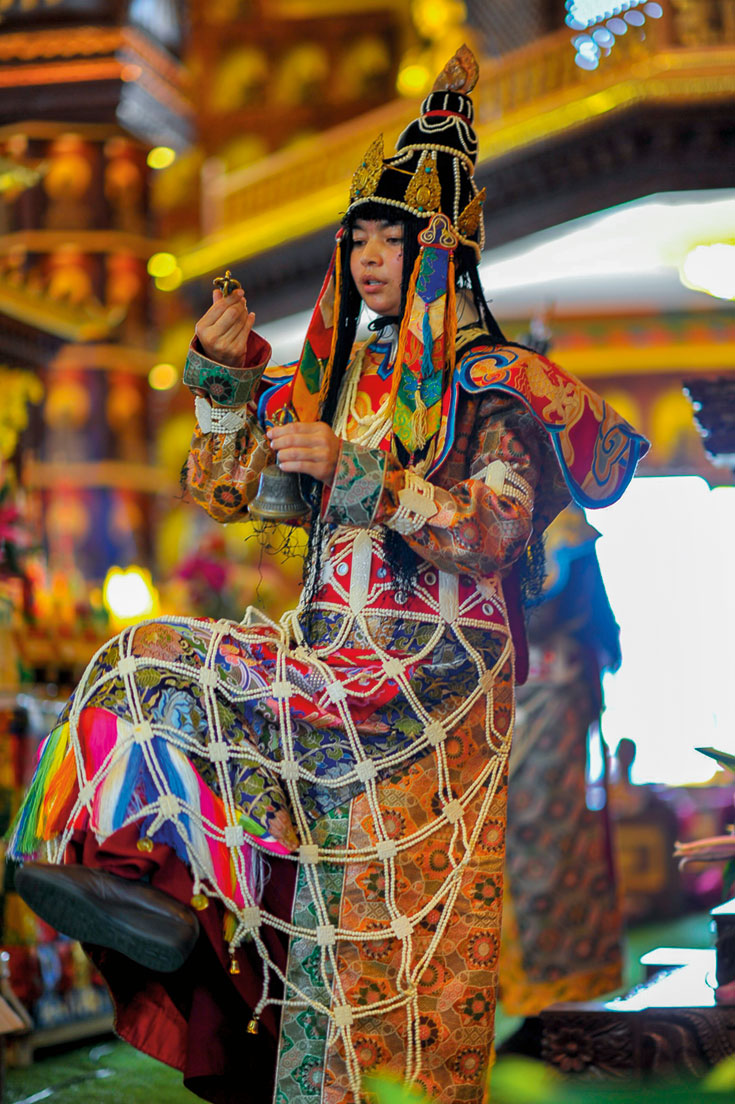
I arrive at Seto Gumba with its hundreds of multicolor, strung prayer flags fluttering in the wind, crisscrossing and connecting the pristine white buildings. Drukpa nun Jigme Choeky greets me with her smiling face and perfect English. She came to the nunnery from her village in North India when she was eighteen years old. She’d been inspired by her cousin, a nun at Dongyu Gatsal Ling, which is headed by the renowned English librarian turned Drukpa nun, Jetsunma Tenzin Palmo.
Although the Drukpa nuns receive a lot public attention for their kung fu skills, I was drawn to visit them for another reason—their practice of cham, the sacred dances that are an essential element of Vajrayana Buddhist ritual and practice. These dances are an outward expression as well as an internal technique of Vajrayana, which holds physical embodiment to be the essential ground on which enlightened transformation takes place. The cham dances have traditionally been off limits to Buddhist nuns.
According to Lopon Jigme Tingdzin, the head administrator of the abbey as well as the dance master who maintains and teaches the dances, the Gyalwang Drukpa entrusted the nuns to perform religious rituals and prayers back in 2001. Then, two years later, he personally began teaching them cham as part of the rituals they were learning. After observing nuns in Vietnam practicing kung fu, he initiated kung fu training for the Drukpa nuns in 2008.
Gyalwang Drukpa is an honorific title given to the spiritual head of the thousand-year-old Drukpa tradition. The current Gyalwang Drukpa, who is the twelfth in the lineage, has been a constant champion of gender equality. He founded his first nunnery in 1992 and today he is responsible for four communities of female practitioners—three in Ladakh and the nunnery at Druk Amitabha in Kathmandu.
In a part of the world where girls and women often have little value or agency over their lives, many have joined underfunded nunneries simply as a refuge from poverty or difficult situations at home. The Drukpa nuns, who are dedicated to spiritual practice and service to others, are setting an inspiring example of monasticism as a truly meaningful life option for women of the region.
The 350 nuns currently at Druk Amitabha adhere to a demanding schedule. They begin each day at 3 a.m. with meditation and morning puja (ritual). Following breakfast, they attend classes in sacred dance, mandala offerings, English, Tibetan, kung fu, etc. After lunch they carry on with classes, text memorization, evening puja, another two hours of meditation, and bed at 10 p.m. A mere couple of tea breaks punctuate the afternoon and evening.
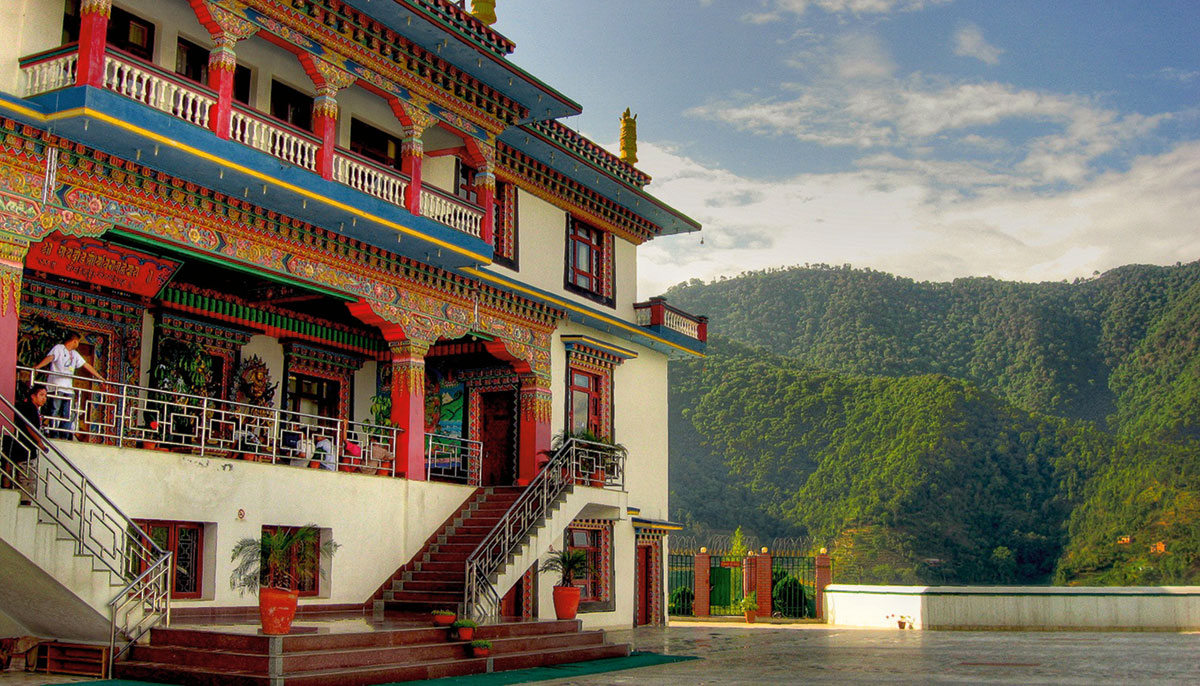
the nuns. Photo by Dhilung Kirat.
Jigme Choeky introduces me to three of her Drukpa sisters, all clad in radiant crimson robes and beret-style Drukpa caps. As Jigme Choeky makes the introductions, I note that each nun’s name begins with Jigme. She explains that Jigme means “fearless one” and is a prefix given to each nun along with her dharma name upon ordination.
I’ve had encounters with underprivileged nuns living in impoverished conditions in the Buddhist Himalayas, and in my experience they’re usually shy and retiring. But these Jigmes carry themselves completely differently. They are fearless! They function as an elite brigade of heroic models for women’s empowerment and guardian protectors of the environment.
Their ethos of fearlessness is exemplified by their committed participation in a transformational update of the age-old tradition of pad yatra (walking pilgrimage). The first “Eco Pad Yatra” in 2009 involved hundreds of Drukpa nuns, monks, and laypeople. They trekked for several hundred miles in the high-altitude reaches of Ladakh, clearing garbage from streams and paths, advising rural villagers about environmental stewardship, and providing religious services.
The yatra has become a defining annual event, each year to a different destination. Now they’ve also expanded to bicycle yatras. With this innovation they set off on frequent half-day cycling pilgrimages through Kathmandu to promote eco-friendly transportation as they visit sacred sites. You can imagine the sensation created by a brigade of nuns cycling around town en masse—not in monastic robes, but rather, in sleek black and red biking gear, sneakers, and shades!
We take a walk around the campus and climb up the central stairway past the dramatic, gleaming statues of Buddha Amitabha and the fourth Gyalwang Drukpa (the illustrious Pema Karpo), which are situated on successive tiers. Then, just around the corner, there they are—a group of little shaven-headed novices dressed in their maroon martial arts uniforms, taking a break after their morning lesson. The youngest, Jigme Ratna Devi, is seven years old. Within the open-sided kung fu pavilion equipped with blue gymnastic floor mats, two accomplished nun instructors practice a brief but formidable sequence wielding gleaming broadswords. The nuns work with other traditional weapons as well, including sabers, halberds, lances, and nunchaku (two bars attached by a chain). Their kung fu training not only builds strong bodies, good posture, and self-confidence, it also cultivates discipline, awareness, and stabilized concentration—skills necessary for meditation practice.
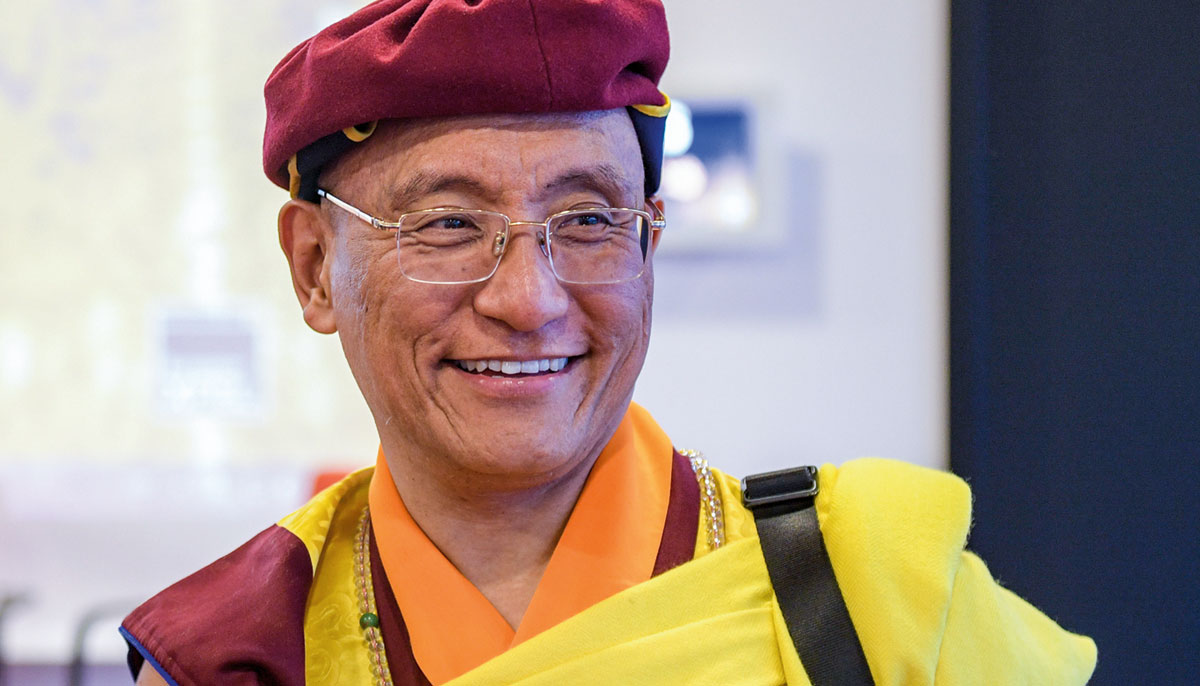
Lopen Jigme Tingdzin shares, “Initially, the kung fu training was a completely new and unfamiliar experience—but exciting. Coming from a small village in Ladakh, I had never even seen it before.” She laughs as she recalls, “It was so difficult and painful at first; there were days we could hardly walk. Although we were already dancing cham, we were unused to the extreme stretching and range of movement. But soon we all felt the deep sense of confidence, strength, and independence produced by the training.”
Lopen Tingdzin now feels kung fu is an indispensable tool for young girls. Within a few years of beginning martial arts training, the nuns started offering self-defense workshops for girls in Ladakh and Delhi. When I ask if there have been concerns for the nuns’ safety and protection, she replies, “In this region, women always feel vulnerable.”
Further along on our walk, three nuns offer to demonstrate a simple, lilting dance for me—right there on the sidewalk. They sing as they move in a line in one direction and then reverse course, occasionally lifting one leg in the air. Their arms gently flow with the movement. This dance, which is performed to a song by the eleventh-
century Tibetan yogi and poet Milarepa, is a folksy contrast to the severe martial art form practiced in the nearby pavilion. The nuns perform this particular dharma dance, called Gurma Cham, for special occasions. It certainly feels special to see it intimately.
Finally we enter the grand Nagarjuna Temple, newly renovated since the 2015 Nepal earthquake. The magnificent interior, built to seat two thousand people, is rich with varied precious materials and elaborate detail. My eye is immediately drawn to the large central gold statue of Padmasambhava, also known as Guru Rinpoche. It’s complemented by a background mural painted azure blue with white curlicue clouds and accompanied by golden statues of standing and seated buddhas and bodhisattvas. Thick, dark wood columns are ornately carved with countless niches housing small Buddha statues, while additional enlightened beings are in the back of the hall, hovering in a glass gallery.
The nuns and I sit down on the grass-green carpet to discuss their cham practice. At their nunnery, they make it clear, “Everybody learns kung fu and everybody learns the dharma dances.” Originally the Gyalwang Drukpa taught them two dances. One was the Nga Cham, a drum dance performed as a celebratory offering that they dance attired in their regular robes draped with golden capes. The other was Kunthub Cham, which is performed to remove obstacles by four dancers wearing wrathful masks. Subduing negativity and obstacles is typically enacted through specific cham at the start of religious rituals. These practices and many other aspects of cham were strongly influenced by pre-Buddhist, indigenous beliefs of the region.
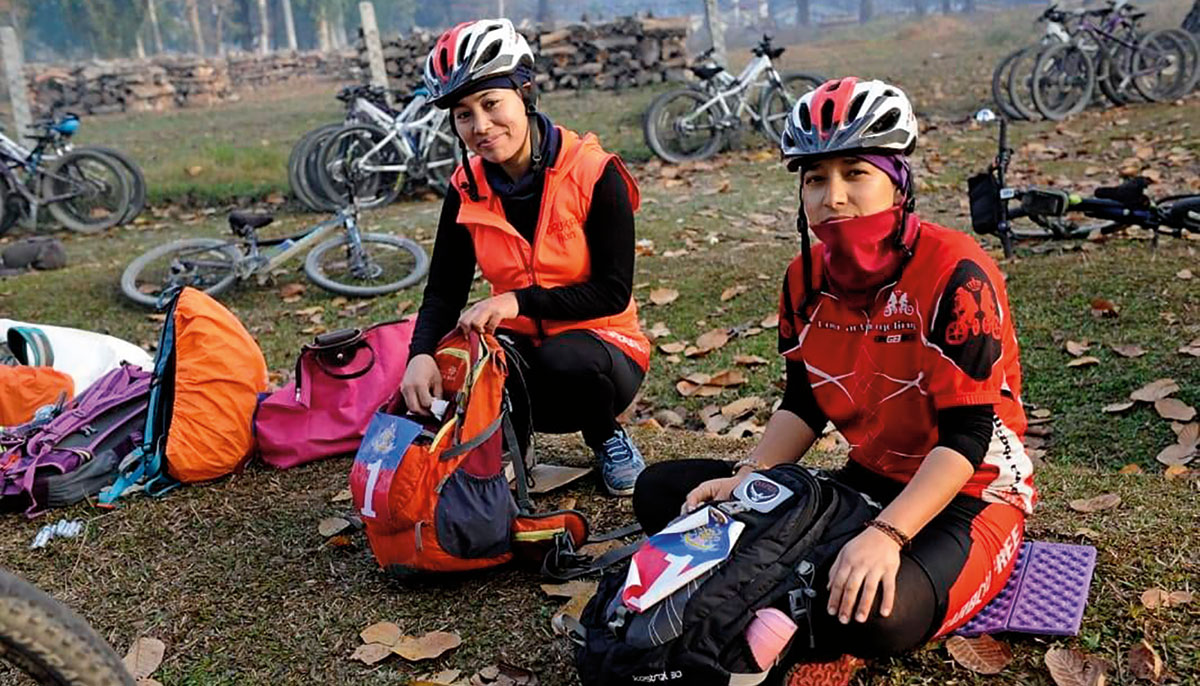
When I ask about the initial reaction to their cham performances, the nuns light up as they recount that many followers from the lay community cried at the surprising sight. “You see,” they tell me, “everyone has such great faith in His Holiness and his vision that they were moved to tears.” I ask about the reaction from the male practitioners and they haven’t much to say. So I pursue this question later with Lopon Jigme Tingdzin.
“When we performed Kunthub Cham for the first time, the male practitioners and great masters in attendance were shocked,” she says. “It had never been done before. We were the first female practitioners to perform dances. Many expressed criticism, and some masters even called it an inauspicious omen. But we never stopped.
“Of course, everyone understood that His Holiness was teaching us directly. So, over time it became accepted and eventually, even admired. Now the Drukpa monks are accustomed to seeing us perform cham as well as act as chant masters for ritual events. However, outside of the lineage, there is still criticism.”
The nuns have since added many more cham to their repertoire, including several dakini dances. For these dakini cham, the dancers wear elaborate silk brocade dresses overlaid with delicate aprons made of bone ornaments. On their heads, they wear wigs of cascading, long, thin, black braids crowned with a five-lobed circlet. The protruding topknot in the center signifies enlightenment.
Dakini (Sanskrit), or khandro (Tibetan), represents the feminine principle of wisdom, or spacious awareness. Nonetheless, dakini dances are traditionally performed by slender young monks—never women—as cham and all ritual performance was a domain restricted to males. The fact that women are performing them now is a significant development. Several years ago Jetsunma Tenzin Palmo sent five nuns from her nunnery in North India to Druk Amitabha to learn the dakini dances. Now they too are dancing these cham at ritual events.
I ask the nuns if they perform any Shanag Cham. These dances are the sole purview of highly accomplished practitioners, and, yes, they perform them! Decked in robes with copious sleeves, long aprons painted with fierce deities, white boots, and tall black hats topped with symbols, the nuns dance the most powerful of sacred dances—Zor Cham. The dancers act as wrathful dharma protectors as they perform mudras holding a three-bladed dagger, a sacred implement used in rituals for dispelling obstacles. Zor Cham is a dance component of a seven-day annual ritual. The zor is a pyramidal dough structure into which malevolent spirits are corralled through meditation and prayer. In the climactic conclusion to the ritual, the zor is hurled into a bonfire in a symbolic exorcism of negativity. The required preparation for this dance is a week of silent meditation.
The nuns acknowledge that they have a unique opportunity in performing these dances. The extent of their cham practice and their openness about it is a telling barometer of change. Though the outside world is wowed by the kung fu chops the nuns have mastered, the fact that they are equally skillful in the performance of cham and other dharma activities has shifted their countrymen’s attitudes on women’s potential and gender equality.
These women are fearless ones.
